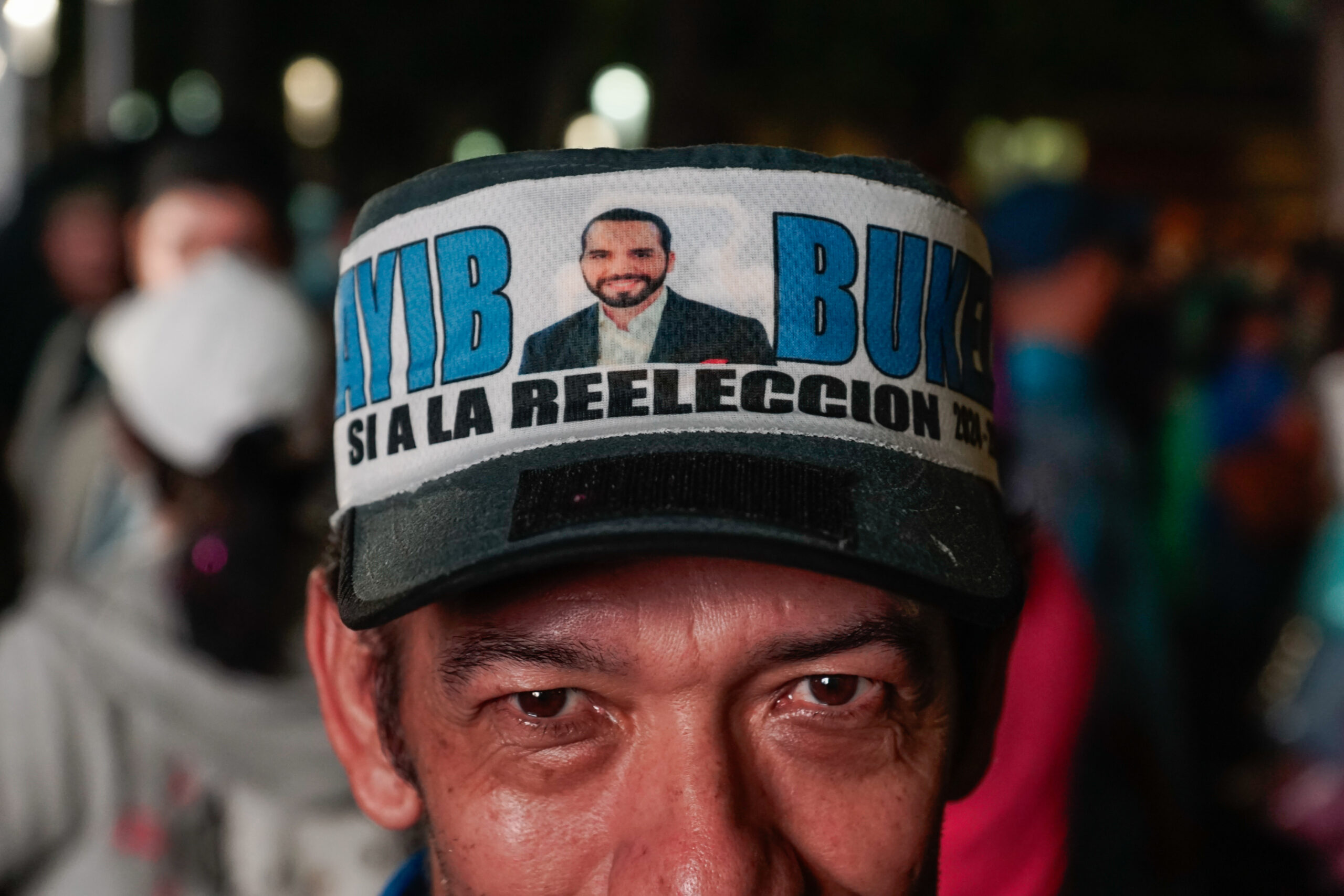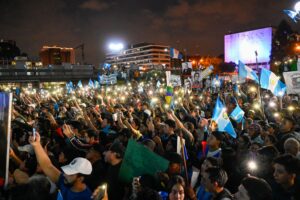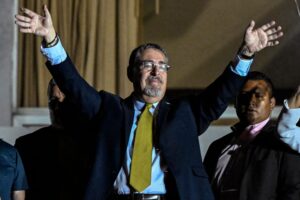
Of course not. But the region’s democratic hopes are fighting an uphill battle against corruption, crime, and a violent past.
By Mateo Jarquín, Rachel A. Schwartz, and Kai M. Thaler
March 2024
On March 8, former Honduran president Juan Orlando Hernández was convicted in a New York court in a major drug-smuggling case. Earlier that week, a United Nations panel of experts said the Nicaraguan government, led by longtime ruler Daniel Ortega, was guilty of human-rights violations that were “tantamount to crimes against humanity.” In El Salvador, President Nayib Bukele effectively proclaimed single-party rule in February after he and his Nueva Ideas party won a landslide reelection, amid allegations of manipulating the vote count. As Latin America’s most popular leader, with an approval rating consistently above 80 percent, everyone expected that Bukele would come out on top.
And there is little doubt as to what the consolidation of the Bukele regime means for Salvadoran democracy. Enjoying domestic and international praise for his crackdown on criminal gangs, Bukele’s path to cementing power has been marked by coopting the legal system, suspending civil liberties, and overt flirting with dictatorship. Ahead of the February vote, Bukele’s vice-president, Félix Ulloa, plainly expressed the regime’s antidemocratic intentions: “To these people who say democracy is being dismantled, my answer is yes — we are not dismantling it, we are eliminating it, we are replacing it with something new.”
Only a few months ago Central America was marked by hopes of democratic renewal. In Guatemala last August, moderate anticorruption reformer Bernardo Arévalo unexpectedly won the presidency, triumphing over a “criminal oligarchy” that had been determined to keep him from office. After those same elites waged a vicious campaign to criminalize Arévalo’s opposition party and block the transfer of power, he was able to assume his duties in January. Still, the shadow of El Salvador’s antidemocratic example looms large, and Guatemala’s establishment forces show no sign of relenting in their lawfare targeting Arévalo’s new government. In Central America, when democratic optimism exists, it is usually fleeting.
The forces of authoritarianism in Central America run deep. In the early 1990s, democratic transitions in El Salvador, Guatemala, Honduras, and Nicaragua ushered in a new political era, but democracy did not flourish. Today, Nicaragua is an outright dictatorship, El Salvador is well on its way to becoming one, and Hondurans’ democratic hopes appear to be faltering. Central America’s democratic transitions did not mark a clear break with the region’s autocratic past. Rather, they empowered elites intent on securing their political and economic interests while erasing mechanisms of accountability. Despite the creation of putatively liberal-democratic institutions, deeply entrenched patterns of state repression, corruption, strongman rule, and socioeconomic exclusion persisted. Counterintuitively, features of Central America’s democratic transitions of three decades ago enabled the rise of a new wave of aspiring authoritarians.
The Rise of Central American Democracies
Until the end of the twentieth century, most Central Americans lived under dictatorships. In the context of the Cold War, U.S.-backed autocrats in El Salvador, Nicaragua, Guatemala, and Honduras concentrated power and systematically violated their citizens’ human rights under the pretext of “saving” them from communism. (Costa Rica was an exception.) Authoritarianism was the norm across Latin America in the 1960s and 1970s. But unlike South American countries such as Chile or Argentina, where democratic governments succumbed to military coups, Central America’s poorer countries lacked a strong tradition of liberal democracy.
During the 1980s, simultaneous armed conflicts rocked the region. In Guatemala, a war had raged since the 1960s, when armed left-wing groups emerged to challenge the repressive, military-dominated establishment installed after a U.S.-backed coup in 1954. The revolutionary-counterrevolutionary dynamic accelerated elsewhere in 1979, when Nicaragua’s Sandinista National Liberation Front (FSLN) led the armed overthrow of the country’s long-ruling Somoza family. Their victory, in turn, intensified fighting in El Salvador between the U.S.-backed conservative government and the FSLN’s insurgent allies, the Farabundo Martí National Liberation Front (FMLN). A second war in Nicaragua then erupted, pitting the new Cuban- and Soviet-backed FSLN government against the contra (counterrevolutionary) forces supported by the United States and anticommunist governments in Central America. Although Honduras was spared the horrors of civil war, it too experienced two decades of military dictatorship and was deeply implicated in its neighbors’ wars, most conspicuously by hosting contra forces.
These interconnected armed conflicts claimed some three hundred thousand lives out of a regional population of roughly thirty million between 1975 and 1991. Many Central Americans would rather forget those years. In 1981, Salvadoran troops committed one of the worst civilian massacres in Latin American history. A UN inquiry published in 1999 found that the Guatemalan military’s counterinsurgency campaign included genocidal violence against Maya communities from 1981 to 1983. Hundreds of thousands fled these and other countries in the region.
In the 1980s, democracy’s prospects in Central America seemed vanishingly remote. Conventional wisdom holds that democracies emerge and flourish in countries experiencing high rates of economic growth. Over the course of the war-torn 1980s in El Salvador, Nicaragua, Guatemala, and Honduras, GDP per capita declined at an average annual rate of 2 percent.
Yet despite the odds, democracy is exactly what Central America got. By the late 1980s, wars on the isthmus had begun to peter out. Neither the right-wing contras in Nicaragua nor the left-wing FMLN in El Salvador could topple their governments. Nor could the Sandinistas or the Salvadoran military eliminate their insurgent foes. Guatemala’s military did effectively defeat the country’s guerrilla groups, but nonetheless needed a political settlement to end the war for good. A relative stalemate between the socialist left and the anticommunist right, combined with international pressure and war fatigue at all levels of society, set the stage for a regional peace agreement. By signing the 1987 Central American Peace Accords in Esquipulas, Guatemala, the region’s presidents agreed to avoid intervening in other countries’ affairs, swore off military aid from foreign superpowers, reached cease-fires with internal opponents, and, crucially, agreed to hold free and fair elections. Waning East-West tensions and a strong international consensus on liberal democracy — especially within Latin America, where at least fifteen countries transitioned away from authoritarian rule between 1978 and 1990 — provided a favorable backdrop.
The 1990s were a new dawn. The Sandinistas’ unexpected defeat in Nicaragua’s February 1990 elections symbolized a dramatic regional shift. Across Central America, civilians increasingly took control of government, and competitive elections and peaceful transitions became standard. National peace agreements in El Salvador (1992) and Guatemala (1996) made full-scale armed conflicts a thing of the past in the two nations. Individual liberties expanded and civil society flourished. Many believed that robust economic growth and poverty reduction would follow.
These hopes were soon dashed. Central America’s young democracies faced obstacles from the outset. The elite bargains ending the armed conflicts excluded most of the population from the political process. As a result, regional transitions were not forged by grassroots prodemocracy movements, but by the very same interests that had waged war and benefited from autocracy. In negotiating for peace, these figures prioritized securing impunity for their past crimes. Their dubious commitments to democracy and human rights spelled trouble for the future of Central American governance.
Democratization, moreover, could not magically solve the problems of poverty and inequality that had driven the Cold War–era cycle of political violence and foreign intervention in the first place. If anything, the standard challenges of underdevelopment were compounded by new problems tied to the social, economic, and psychological tolls of war. What political scientists call the “structural” or “objective” conditions for democracy were therefore almost entirely absent in Central America (something many observers, swept up in the “end of history” Zeitgeist, failed to notice). These problems were shared by many countries that rode the “third wave” of democratization in Latin America, but Central America’s democratic transitions were exceptionally shallow.
The Decline of Central American Democracies
Though Central American countries avoided relapses into civil war, the cracks in the region’s fragile democratic architecture surfaced early on. The thin democratic transitions, which failed to remake the political rules of the game, set the stage for subsequent democratic decline. Onerous requirements for starting new political parties ensured that only the well-resourced had the chance to compete successfully for office. Amnesty agreements helped to end fighting, but ensured that both government officials and rebel fighters who violated human rights in the 1980s would go unpunished while remaining politically powerful. These same violent and authoritarian groups then seized the opportunity presented by growing criminal violence — particularly in Guatemala, El Salvador, and Honduras — to deflect demands for security-sector reform and transitional justice. The reformed judicial systems, meanwhile, were corrupt, distorting the rule of law.
Nicaragua’s transition was undermined by elite political bargains. Opposition leader Daniel Ortega, who ran the Sandinista government during the 1980s, forged a power-sharing agreement with President Arnoldo Alemán (1997–2002) that saw both strongmen seize control of the state. Their deals rewrote electoral rules such that Ortega was able to win back the presidency in 2006 with only 38 percent of the vote. In El Salvador, a two-party democracy faltered as insufficient reforms and rising criminal violence — due in large part to the mass deportation of mara gang members from the United States — combined to extend state repression and human-rights violations into the 1990s and 2000s. Guatemala’s democratic transition was also stunted from the start. As the country’s war ended, a loose authoritarian coalition — composed of traditional political elites, business leaders, ex-military officials, and organized criminal interests — conspired to undermine reforms that aimed to raise tax revenues, recognize indigenous rights, strengthen the judiciary, and lower barriers to political competition.
The weak foundations of Central America’s new democracies set the stage for significant authoritarian regressions by the late 2000s, as corrupt interests encountered little pushback to their increasingly autocratic tactics. In 2009, a military coup in Honduras ousted President Manuel Zelaya after he adopted leftist domestic and foreign policies and called for a constitutional referendum. The next twelve years of conservative rule saw growing penetration of organized criminal groups within government, the overturning of a constitutional prohibition on presidential reelection, and state repression against protestors following alleged fraud in the 2017 election.
In Nicaragua and El Salvador, democratic backsliding accelerated through the concentration of power by personalist leaders. Nicaraguan president Daniel Ortega, at the helm once again since 2007, leveraged alliances with business and church elites to harass critics, rig elections, and coopt all state institutions (including, notably, security forces). In El Salvador, “millennial authoritarian” Nayib Bukele similarly redrew the country’s politics in his image. Having won the presidency in a landslide in 2019, he used his popularity — and widespread public approval of his draconian security policies — to install regime loyalists in the judicial system, paving the way for him and his party to stay in power.
Guatemala lacks a similar omnipotent personality, but has not escaped authoritarianism. After an unprecedented, UN-backed anticorruption campaign sought to unmask the corrupt elites controlling Guatemalan politics in the 2010s, the administrations of Jimmy Morales (2016–20) and Alejandro Giammattei (2020–24) persecuted journalists, prosecutors, and activists to preserve elite impunity; some government opponents landed behind bars, and many more were forced into exile.
Today, Central American democracy is in its worst shape since the 1980s. In Nicaragua, there is no longer any liberal democracy to speak of. Following massive antigovernment protests in the spring of 2018, Ortega and his vice-president and wife, Rosario Murillo, unleashed brutal violence against the population, killing hundreds and prompting accusations of crimes against humanity from the UN. The Ortega regime continues to exile and jail anyone who dares speak against it in a manner shockingly similar to the repressive, dynastic Somoza dictatorship that the Sandinista Revolution overthrew in 1979.
El Salvador’s Bukele continues to assault the country’s democratic institutions, and his crackdown on gangs — which has jailed more than seventy-thousand people — has outraged human-rights groups, who allege widespread abuses including torture, disappearances, and arbitrary detentions. But these efforts have sent Bukele’s approval soaring at home and abroad. The Supreme Court, at the behest of Bukele, removed the constitutional ban on consecutive reelection ahead of the 2024 contest, making dictatorship all but a foregone conclusion.
In Honduras, the 2021 elections brought the peaceful alternation of power, to the surprise of many. The optimism that surrounded the early tenure of new president Xiomara Castro (wife of Manuel Zelaya) has faded, however, due to the ruling party’s manipulation of legislative procedures to enforce her will and her administration’s use of tough-on-crime laws modeled after those of Bukele, resulting in civil and human-rights violations.
Guatemala’s 2023 elections offered a new hope. Despite prior restrictions, little-known reformist politician Arévalo slipped through the cracks, pulling off a stunning victory. But Attorney General María Consuelo Porras and allies then used legal stunts to disband Arévalo’s Semilla party and strip opposition legislators and electoral authorities of their prosecutorial immunity, and attempted to invalidate the election results — all in a bid to block the transfer of power. Civil society resistance at home, combined with robust international pressure, thwarted this attempted coup, and Arévalo has made Porras’s resignation one of his first priorities. Antidemocratic forces, however, threaten to make it impossible for Arévalo to carry out his anticorruption agenda, as the Constitutional Court upholds injunctions against Semilla and Porras clings to power.
What Went Wrong?
Where did Central America’s democracies go wrong? Despite their distinct trajectories, Central American countries’ experiences reveal some common drivers of authoritarian regression. The urgent need to end armed conflict and military rule brought concessions that entrenched the power of political and economic elites, and institutionalized impunity for human-rights violations — which soon enabled impunity for corruption as well. Deficiencies in security-sector reforms bred weak and corrupt police forces and fueled crime and violence. Growing inequality exacerbated social and economic misery in the region and left citizens clamoring for a different kind of leadership that would dispense with democratic procedures in favor of quick, decisive action.
The result has been widespread dissatisfaction with democracy. The AmericasBarometer has found that support for democracy has declined or stagnated in every Central American country except El Salvador since 2010; meanwhile, polarization combined with high approval for Bukele’s government means that more than half of Salvadorans hold attitudes conducive to authoritarian stability and appear willing to discard democracy if their preferred political leader is in power.
A sometimes permissive international environment has also facilitated democratic backsliding in Central America. The Organization of American States suspended Honduras for two years following its 2009 coup, and demanded that Guatemala’s outgoing government respect the popular will in the wake of that country’s 2023 elections. But the body has been less assertive in confronting autocratization in Nicaragua and El Salvador, even as those governments have clearly violated the Inter-American Democratic Charter, which all OAS members have signed, by restricting civil liberties, manipulating elections, and, at times, wielding repression.
U.S. resistance to authoritarian power grabs in the region has likewise been inconsistent. Zelaya’s ouster in Honduras, Ortega’s authoritarian drift in Nicaragua (at least until the 2018 massacres), Bukele’s recent unabashedly antidemocratic moves in El Salvador, and even the Giammattei regime’s efforts to exclude anti-establishment candidates in the leadup to the 2023 election were all met with little pushback from the United States. In Guatemala, the Biden administration ratcheted up pressure significantly only following the contest, once the regime’s attempt to overturn the results and prevent the transition became much more blatant.
More recently, the politics surrounding unauthorized migrants crossing into the United States along its southern border may have encouraged a somewhat muted response to the backsliding from the Biden administration, which has been seeking regional cooperation on curbing migration. U.S. officials consumed by domestic political concerns, meanwhile, have prioritized migration over governance when crafting policy on Central America, even though virtually all agree that the lack of rule of law is among the “root causes” of emigration from the region. Indeed, Central American countries’ deficiencies in democracy and basic freedoms, as well as the rule of law, are key contributors to insecurity and migration.
Yet, although regional collaboration on migration has been proven possible, the Biden administration appears increasingly willing to tolerate Bukele’s assault on democracy in El Salvador in exchange for controlling migrant transit and keeping Chinese influence at bay; and Ortega has weaponized and profited from U.S. preoccupation with migration by opening Nicaragua’s borders to migrants from Cuba, Haiti, India, and elsewhere.
Likewise, the shifting geopolitical landscape has also emboldened Central America’s autocrats. China’s increasing influence in Latin America means new sources of finance and investment, prompting every Central American country except for Guatemala and Belize to break off ties with Taiwan and cozy up to Beijing.
Authoritarianism has advanced thanks to political learning as well, as Central American elites adopt antidemocratic tactics from one another. In late 2021, Bukele proposed a foreign-agents law styled on Ortega-regime legislation that would force organizations receiving funds from abroad to register with the government, with the Nicaraguan law and similar measures in Russia used to target and restrict human-rights watchdogs, nongovernmental organizations, and civil society groups. Although El Salvador’s proposed law was shelved, Bukele has deployed other strategies from the Nicaraguan playbook, threatening journalists, filling the state apparatus with loyalists, and using government contracting to enrich family members. Both the Honduran and Salvadoran governments followed Guatemala’s example by ousting their internationally backed anticorruption commissions, using the language of national sovereignty and taking advantage of wavering U.S. democratic commitments under the Trump administration (2017–21). And regional financial institutions such as the Central American Bank for Economic Integration have propped up the Ortega regime with little outcry from neighboring countries.
Another Chance?
Can democracy in Central America get another chance? Domestically, it is crucial for opposition parties and civil society organizations to hold antidemocratic leaders accountable however they can, but also to settle their differences and forge unity. Nicaragua’s fragmented opposition eased Ortega’s path to dictatorship, while decades of division among Guatemala’s moderate and progressive sectors helped consolidate the corrupt class of elites that control the country’s politics. By contrast, unity candidate Violeta Chamorro’s unexpected win in Nicaragua’s 1990 election sparked that country’s transition to democracy. Similarly, broad opposition fronts behind Xiomara Castro in Honduras in 2021 and Bernardo Arévalo in Guatemala in 2023 enabled surprise victories. Given citizens’ loss of faith in democracy, it is crucial that prodemocratic forces make the case for why democratic governments are best positioned to deliver on their promises and that democracy offers the best chance of addressing key public concerns such as security, corruption, and inequality.
Central America may not be a major economic player in the hemisphere, but the region’s authoritarian dynamics have the potential to spread. Leaders elsewhere in Latin America look with envy at Bukele’s popularity as he tramples on civil rights to eliminate gangs. Leaders such as Argentina’s new far-right president Javier Milei are clearly taking notes.
Latin American countries took the lead in helping Central America to democratize in the 1990s, and U.S. policymakers should work collaboratively with hemispheric governments on prodemocracy efforts. Heavy-handed, unilateral U.S. actions can provide authoritarians with easy nationalist rhetoric to defend themselves and attack opponents, or they can polarize Latin American countries, as backing for Juan Guaidó’s parallel government in Venezuela did.
History offers lessons for how to move forward. First, efforts to restore democracy should tackle Central America as a whole. Individual efforts that target one country will struggle. Restoring democracy in Central America will also take patience and planning. Short-term concerns allowed human-rights violators and corrupt, authoritarian elites to keep their claws on political power and sidestep pressure for socioeconomic equality during Central America’s last democratic transition. Those who support democracy’s cause in Central America must ensure that they do not repeat the same mistakes if the region is to democratize again — and, this time, make it last.![]()
Mateo Jarquín is assistant professor of history at Chapman University and the author of The Sandinista Revolution: A Global Latin American History (2024). Rachel A. Schwartz is assistant professor of international and area studies at the University of Oklahoma and the author of Undermining the State from Within: The Institutional Legacies of Civil War in Central America (2023). Kai M. Thaler is assistant professor of global studies at the University of California, Santa Barbara.
Copyright © 2024 National Endowment for Democracy
Image Credit: APHOTOGRAFIA via Getty Images
| FURTHER READING | ||

Latin America Erupts: Millennial Authoritarianism in El SalvadorNayib Bukele has developed a blend of political tactics that combines populist appeals and classic autocratic behavior with a polished social-media brand. It poses a dire threat to the country’s democratic institutions. |

How Guatemalans Are Defending Their DemocracyThe economy is spiraling, public frustration is mounting, and the regime is becoming more repressive. The next time Egyptians come to the streets, they will be looking for more than promises and free elections. |

A Shock to Guatemala’s System |
